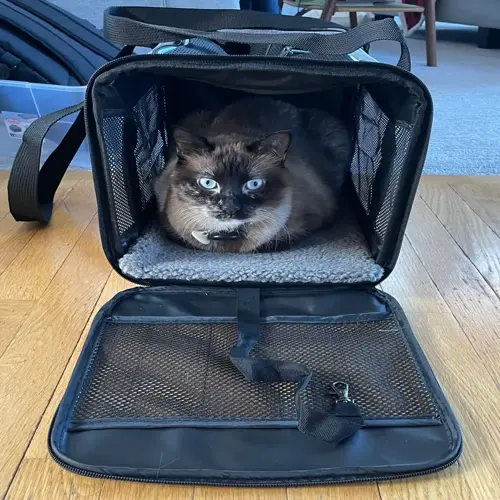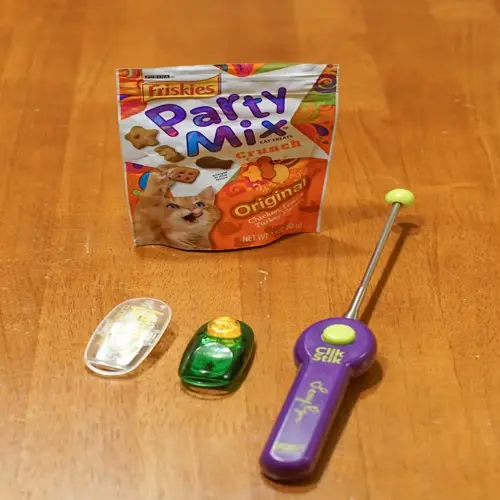Essential Cat Enrichment Activities Guide

Written by
Victoria Hayes
Reviewed by
Prof. Edward Clarke, Ph.D.Activities that provide enrichment to cats help to lessen boredom and minimize destructive behavior in your cat.
Puzzle feeders encourage the natural hunting behaviors cats exhibit when they hunt for food daily.
Cat trees-toys that provide vertical height-provide essential climbing territory for cats to safely play and explore.
Catios like supervised or outdoor areas allow your cat to explore a new environment safely.
Interactive play sessions with you promote the relationship with your cat through play and interaction.
Consistent enrichment in the home environment will help to further alleviate any pent-up energy, which decreases the staff-related stress problems in cats.
Article Navigation
Cat enrichment activities involve providing opportunities for your cat to express such instincts as stalking, climbing, and foraging. These activities keep cats mentally alert and physically active, reducing stress and destructive behavior. You will notice a happier cat during social interactions.
Taking these steps helps reinforce your attachment to your cat while addressing common problems such as scratching furniture. Each domestic cat can profit from simple changes in its environment. I have observed a notable improvement in a nervous cat through the use of persistent enrichment techniques.
This guide includes ideas for feeding puzzles, vertical spaces, and sensory experiences. All suggestions require little effort and can be started today using household supplies. My own cats flourish under these routines, serving as proof of the accessibility of feline enrichment to all owners.
Feeding Enrichment Essentials
I believe that puzzle feeders are excellent jumping-off points for starting cat enrichment. They transform mundane meals into rewarding hunting experiences for your cat. Your cat will have to earn their food just like in the wild. This mental stimulation can help reduce boredom that can arise from a strict feeding routine. I started with straightforward DIY puzzles made from empty plastic bottles with holes poked into them. My cats figured out quickly that they could bat them to receive kibble rewards!
You can create effective feeders without spending money. Try cutting holes in yogurt containers or using muffin tins instead. These homemade solutions offer the same mental challenge as store-bought ones. I have saved more than $50 a month by using recycled materials. Rotate different DIY puzzles each week to keep your cat interested.
Portion foods carefully for health. Serve 1/4 cup (30g) per day through these feeders. Separating daily food into multiple small puzzles helps reduce eating speed and the risk of obesity. I have been feeding my cats this way for two years, and they are at an ideal weight.
Feeding enrichment turns mealtime into a fun challenge. Your cat remains physically active while brainstorming. It mimics natural foraging behavior. This assures a happier, healthier feline companion. Start with one puzzle today, then witness the positive changes in cat behavior and energy.
Play and Mental Stimulation
Wand toys are essential for fulfilling your cat's instincts to hunt. The fluttering feathers are exact replicas of the movements of real prey! I keep several wands on hand to use in daily exercises and play. It is a thrill to see your cat leap and pounce, elongating their body completely. This is also an excellent physical exercise.
Use laser pointers safely by ensuring that you always end with a tangible result. Let your cat have a toy or treat that it can catch after chasing the light. Otherwise, it can lead to frustration, as cats require closure for their hunting routine. I learned this through trials with my cats.
To keep toys from becoming boring, rotate inexpensive toys on a weekly basis. Ping Pong balls are great for batting practice. Cardboard boxes make instant places for exploration. Simple items can help alleviate boredom without requiring a significant investment. I change mine every Sunday morning without fail.
Limit training sessions to a maximum of five minutes. Cats get bored easily, increasing the chance of failure, so teach tricks in tiny bites. Learn something simple, like sit or touch. Deliver high treat rewards immediately. This systematic approach to augmentation effectively improves the confidence level over time.
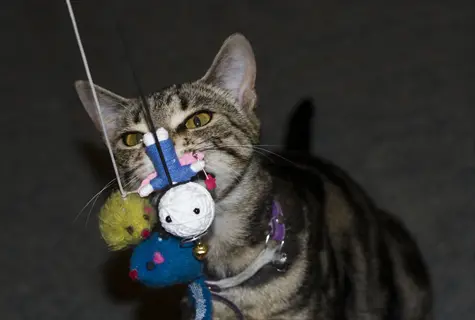
Interactive Wand Play
- Fact: Mimics prey movement triggering natural hunting instincts
- Safety: Requires supervision due to string ingestion risks
- Tools: Feather teasers or fabric attachments work best
- Duration: Ideal for 10-15 minute play sessions twice daily
- Engagement: Cats fully extend during leaps and pounces
- Variety: Vary movements (fluttering, scurrying) to maintain interest
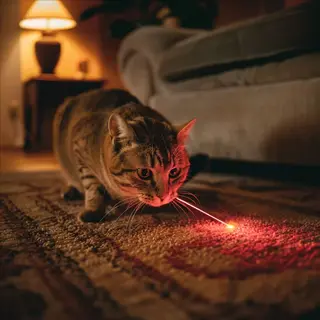
Laser Pointer Games
- Fact: Provides visual stimulation without physical contact
- Safety: Never shine directly in eyes; use low-power devices
- Frustration Prevention: Always end with caught toy or treat
- Patterns: Move in unpredictable zigzags to mimic insects
- Surface Consideration: Works best on non-reflective floors
- Limitations: Not suitable for cats with vision impairments
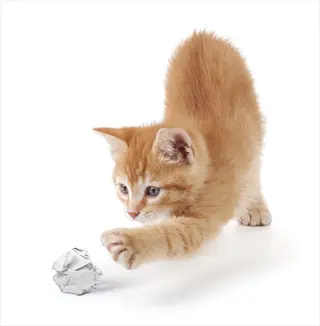
Novel Object Rotation
- Fact: Novelty triggers curiosity and exploration behaviors
- Household Items: Wadded paper balls, plastic rings, cardboard tubes
- Rotation: Change objects every 7 days to prevent habituation
- Safety Check: Ensure no small detachable or ingestible parts
- Placement: Scatter in open areas to encourage discovery
- Cost: Zero-budget option using recycled materials
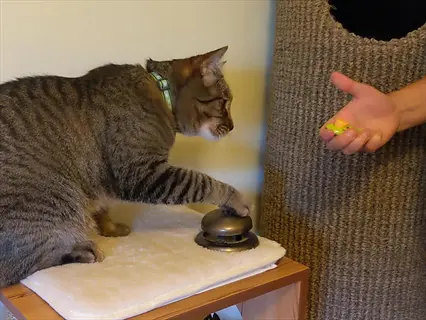
Feline Training
- Fact: Uses same reward-based principles as dog training
- Tools: Clickers mark desired behaviors followed by treats
- Duration: Maximum 5-minute sessions to maintain focus
- Foundation Skills: Start with 'sit' or 'touch target'
- Advanced Tricks: Gradually build to carrier entry or nail trims
- Rewards: Use high-value treats like freeze-dried chicken
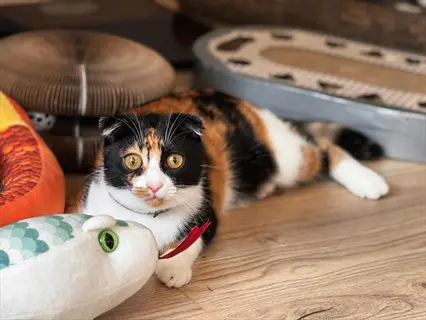
Self-Play Solutions
- Fact: Fulfills independent play needs when owners are away
- Options: Battery-operated moving toys or treat-dispensing balls
- Placement: Position near resting spots for easy access
- Supervision: Monitor initial interactions for safety
- Rotation: Store unused toys with catnip to renew scent interest
- Limitations: Never substitute for human interaction entirely
Vertical Spaces and Retreats
Vertical space provides important security for cats, giving them a safe vantage point to look over their territory. It was immediately apparent in my home that vertical surfaces were the answer to the conflict between my 3 cats. Each cat needs at least one high perch to feel secure in its environment.
When selecting cat trees, ensure the scratching posts are at least 24 inches (60cm) in height, allowing them to stretch their whole bodies during scratching exercise sessions. Successful scratching sessions are beneficial for claw health and establishing territory. My cats consistently prefer taller scratching posts than shorter ones for their daily stretching sessions.
Mount window perches with a view of outdoor activities, such as bird feeders. This creates natural visual stimulation for the indoor cat. I placed mine with a view of our backyard feeder, and it was my cat's favorite spot. Rotate perch locations seasonally for an interesting view.
Cardboard boxes offer no-cost, instant retreats for fearful cats. Please place them in quiet corners so that they have more than one entry point. Line the boxes with your worn t-shirts so that they will have familiar, comforting scents. My anxious rescued cat quickly learned to find refuge in these simple hideaways.
Cat Trees and Towers
- Function: Satisfies climbing instincts and provides observation points
- Placement: Position near windows or family activity areas
- Height: Minimum 24 inches (60cm) for adequate stretching
- Multi-Cat Tip: One tower per cat plus extra to reduce competition
- Materials: Sisal-wrapped posts withstand vigorous scratching
- Maintenance: Vacuum weekly to remove loose fur and dander
Wall-Mounted Shelves
- Function: Creates elevated pathways in small spaces
- Installation: Secure to studs with 50lb (22.7kg) weight capacity
- Spacing: 12-18 inches (30-45cm) between shelves for easy jumping
- Safety: Round edges prevent injuries during play or falls
- Covering: Carpet or fleece provides grip and warmth
- Path Design: Create circular routes ending at food/water stations
Window Perches
- Function: Allows safe outdoor viewing and sunbathing
- Orientation: Face bird feeders or garden areas for maximum interest
- Materials: Suction cups work on smooth surfaces; brackets for others
- Size: Minimum 18x12 inches (45x30cm) for average-sized cats
- Comfort: Add removable fleece pad for easy washing
- Avoidance: Position away from rival cat sightlines to prevent stress
Hiding Spots
- Function: Provides security during anxiety or naps
- DIY Options: Cardboard boxes with multiple entry/exit points
- Placement: Under beds or behind furniture in low-traffic areas
- Comfort: Line with blankets retaining owner's scent for reassurance
- Multi-Cat Tip: Ensure one hide per cat in separate zones
- Rotation: Replace boxes monthly to maintain novelty and cleanliness
Multi-Level Rest Areas
- Function: Enables territory sharing without confrontation
- Design: Connect cat trees, shelves, and perches in continuous paths
- Height Variation: Include platforms at 12, 24, and 36 inch levels
- Accessibility: Add ramps for kittens or senior cats
- Feeding Stations: Place food bowls on mid-level platforms
- Observation: Note which levels each cat prefers for personality insights
Sensory and Outdoor Enrichment
A catio provides a safe outdoor experience for cats, eliminating the dangers of traffic and predators. It is an enclosed area that allows cats to go outside and enjoy the fresh air and the outdoors. My catio features shelves for them to climb on, scratching posts, and hanging toys to play with, providing environmental stimulation for my cats while keeping them safe and secure.
When leash training your cat, patience is key, so start inside first. It may take several days for your cat to get used to the harness. Start with short sessions inside the house and move outside later. I would practice with my cat for about 10 minutes a day until she got used to it.
Sow pet-safe grasses such as wheat or oats in accessible pots. These will provide tactile stimulation and safe nibbling opportunities. Position the pots near resting areas where the pets can easily reach them. I rotate the pots weekly to maintain the cats' interest in these sensory gardens.
To experience the best viewing of the feeders, place them 3-5 feet (0.9-1.5 meters) away from windows. This will prevent birds from striking the windows while maintaining the best visibility. I've had my feeders that distance away providing hours of fun to my inside cats. The combination of this and the window perches seems to provide the maximum entertainment for them.
Catio Construction
- Function: Provides safe outdoor access with environmental control
- Size: Minimum 6x4ft (1.8x1.2m) for one cat; add 3ft² (0.9m²) per additional cat
- Enrichment Additions: Incorporate shelves, scratching posts, and hanging toys
- Safety: Use 16-gauge wire mesh; check monthly for damage or weakness
- Weather Protection: Include covered areas and waterproof bedding
- Plant Integration: Add cat-safe potted grasses for tactile stimulation
Leash Training Steps
- Preparation: Introduce harness indoors with treats over 3-7 days
- First Steps: Attach leash briefly during indoor play sessions
- Outdoor Transition: Start in quiet, enclosed areas like backyards
- Duration: Limit initial walks to 5-10 minutes; gradually increase
- Distraction Handling: Use high-value treats during startling noises
- Alternative: Pet strollers for cats resistant to harnesses
Sensory Gardens
- Function: Stimulates smell, taste, and touch through plants
- Indoor Options: Pots with catnip, cat grass, or valerian root
- Placement: Near resting areas or windowsills for easy access
- Toxicity Check: Verify safety via ASPCA's plant database
- Maintenance: Replace grasses every 2-3 weeks for freshness
- Engagement: Crush leaves occasionally to release aromatic oils
Window Viewing Stations
- Function: Allows visual stimulation without outdoor risks
- Setup: Install perches 12-18in (30-45cm) wide with fleece padding
- Height: Position at cat's standing eye level (8-12in/20-30cm high)
- Enhancements: Add bird feeders 3-5ft (0.9-1.5m) from window
- Avoidance: Use curtains to block views of territorial cats
- Rotation: Change perch locations seasonally for new perspectives
Auditory Enrichment
- Function: Provides mental stimulation through species-specific sounds
- Options: Cat-specific music or nature recordings at low volume
- Duration: 1-2 hour sessions; observe for overstimulation signs
- Avoidance: Skip high-pitched sounds exceeding 65 decibels
- Interaction: Pair with calm petting or treat-dispensing toys
- Effectiveness: Most beneficial for anxious or solitary cats
Calming and Social Strategies
Grooming sessions have a double function for long-haired cats: to prevent painful matting of the hair and to give the pet an experience of security and comfort and its owner a moment of bonding contact. I groom my Persian daily, turning it into a period of our personal association. Betake it to when the cat becomes irritated and stop before that point. Treats may be of service at different times in the grooming process.
Install Feliway diffusers in the primary resting areas at all times. These synthetic pheromones produce anti-anxiety measures around the clock. Place these near beds and favorite napping areas for the best effect. I observed a decrease in stress-related behaviors in my anxious cat in just a few days.
Begin slow introductions with separate resources: separate food/water bowls, litter boxes, and sleeping spot at first. Next, begin by swapping scents on blankets and then visual introductions. My successful multi-cat household followed these gradual steps.
Water fountains help improve hydration by providing mobility opportunities for cats. Place the fountain away from food bowls since cats will instinctively avoid drinking areas close to where they eat. Fountain water should be changed weekly to limit bacteria build-up. My cats drink remarkably more after switching to water fountains.
Stress-Reduction Techniques
- Function: Lowers anxiety through predictable routines and environmental controls
- Consistency: Feed and play at same times daily for security
- Pheromones: Use Feliway diffusers in main resting zones continuously
- Safe Spaces: Maintain accessible hiding spots during high-stress events
- Sound Management: Play soft music during thunderstorms or fireworks
- Observation: Note lip-licking or ear-flattening as stress indicators
Grooming as Bonding
- Function: Combines physical care with positive social interaction
- Tools: Select brushes matching coat type (slicker for long hair)
- Duration: 5-10 minute sessions; stop before signs of irritation
- Rewards: Offer treats during grooming to create positive associations
- Technique: Follow fur direction; avoid sensitive belly areas initially
- Multi-Cat Tip: Groom cats separately to prevent competition
Multi-Cat Household Strategies
- Function: Prevents conflict through resource management and space division
- Resources: Provide one litter box per cat plus extra in separate zones
- Feeding Stations: Place bowls in different rooms to reduce competition
- Vertical Space: Install perches at varying heights for territory claims
- Introduction Protocol: New cats need 2-4 week gradual scent-swapping
- Conflict Signs: Watch for staring or blocking access to resources
Hydration Enhancement
- Function: Increases water intake to support urinary tract health
- Fountain Types: Ceramic or stainless steel with quiet motors
- Placement: Keep away from food bowls (cats instinctually avoid)
- Cleaning: Disassemble and wash weekly with vinegar solution
- Alternatives: Add broth ice cubes or wet food to increase moisture
- Monitoring: Check for 3-4 oz (90-120ml) daily intake per 5lb (2.3kg) cat
Human-Cat Interaction
- Function: Strengthens bonds through species-appropriate engagement
- Reading Aloud: Use calm tones for 10-15 minute sessions
- Touch Preferences: Respect when cats move away from petting
- Play Signals: Recognize slow blinks as invitations to interact
- Training Integration: Combine short tricks with affection rewards
- Child Education: Teach gentle chin-scratching instead of full-body hugs
5 Common Myths
Felines are loners by nature and do not partake in social interaction or enrichment actions to satisfactorily live in home surroundings.
Cats, while more self-sufficient than dogs, require periodic mental stimulation and social interaction to avoid behavioral problems. Enrichment activities provide natural behavior and serve to greatly relieve stress in domestic cats. Puzzle feeders, climbing things, and interactive play simulate hunting behavior, which is necessary for psychological well being. Without these, cats often develop anxiety-provoking problems which affect their general health.
Puzzle feeders and food-dispensing toys are too hard for most cats to utilize, and are frustrating to them instead of enriching.
Most cats quickly learn how to use puzzle feeders if they are gradually introduced with simple designs. Training with shallow dishes or rolling bottles builds success while eliciting natural foraging instincts. These things slow the rate of eating, promoting less obesity while incorporating mental enrichment. Frustration usually results only if the owner jumps phases in training or uses too complex of puzzles at first.
It's inhumane to confine cats indoors exclusively. They need unrestricted access to outdoors for satisfaction due to their instincts.
Supervised ways to enjoy outside access like catios and leash walks give needed enrichment while they are kept out of harm's way, such as from traffic and predators. Indoor cats live longer, much healthier lives if given environmental stimulation. Controlled access to outdoor areas through safe window perches or sensory gardens can satisfy the needs for exploration safely. This balanced approach fulfills feline enjoyment of life but makes unrestricted freedom unnecessary.
Cats cannot be trained like dogs because they don't have the intelligence or the desire to learn commands and tricks.
Cats have a strong capacity for learning, as demonstrated when reward-based training methods are used that relate appropriately to their motivations. Tricks like high-fives and come are effectively taught using very short training sessions of under 5 minutes and high-value treats. Training enriches the human-cat bond and provides important mental stimulation. The misunderstanding comes from not understanding how intelligent cats are and how different their kinds of motivation are.
Scratching furniture is inevitable destructive behavior that means cats are unhappy or poorly trained.
Scratching serves essential claw maintenance and territory marking purposes, not destruction. Providing appropriate scratching posts with preferred materials like sisal redirects this instinct effectively. Strategic placement near resting areas attracts consistent use. Most cats use designated posts when introduced properly, preserving furniture while fulfilling natural needs.
Conclusion
Activities that provide cat enrichment are a must, not an option, and are essential for feline health and wellbeing. The natural, instinctual needs they fulfill in a cat's life will prevent stress-related illnesses and costly veterinary bills. I have seen wonderful health improvement in both cats and kittens that receive continuous enrichment. So, begin today, even with just one simple method, such as puzzle feeders.
Little daily efforts reap many long-term benefits. Playing for just five minutes, such as giving a cardboard box, can help prevent obesity and anxiety problems. These little efforts, however, also strengthen your bond and save expenses in the future. The bright health of my own cats proves how effective these routines are.
Start slowly with one enrichment activity and gradually build upon it. You will notice happier interactions and fewer behavioral challenges. It takes careful and consistent use of enrichment activities to create a good relationship with your cat. I adore the deeper connection I feel with my cat companions through these activities.
Your commitment to enrichment creates a thriving environment. It pays off with years of delightful company and a shared understanding. Start small today, and see how much you can build up your relationship with your cat day after day. The reward far exceeds the small effort involved.
External Sources
Frequently Asked Questions
What are essential cat enrichment activities?
Key activities include puzzle feeders for mental stimulation during meals, vertical climbing structures for territory control, interactive play sessions mimicking prey, sensory gardens with cat-safe plants, and designated scratching posts. These fulfill natural instincts while preventing behavioral issues.
How do I enrich my indoor cat's life?
Focus on these core areas:
- Daily interactive play sessions with wand toys
- Window perches for bird watching
- Rotation of novel objects like cardboard boxes
- Food puzzles to engage hunting instincts
- Vertical spaces for climbing and observation
What are signs of cat boredom or understimulation?
Watch for excessive sleeping beyond normal patterns, destructive scratching on furniture, overgrooming leading to bald patches, aggressive behavior toward people or pets, and constant vocalization. These indicate unmet mental and physical stimulation needs requiring enrichment adjustments.
How much playtime do cats need daily?
Cats require at least two 15-minute interactive play sessions daily using toys that mimic prey movements. Additionally, provide self-play opportunities through puzzle feeders and climbing structures. Senior cats need shorter but more frequent engagement periods.
Can household items work for cat enrichment?
Absolutely! Try these zero-cost solutions:
- Cardboard boxes with cut-out entry points
- Toilet paper rolls stuffed with treats
- Ice cubes with frozen broth for batting
- Wadded paper balls for chasing
- Blanket forts for hiding and exploration
Is outdoor access necessary for cat happiness?
No, supervised alternatives like catios or leash walks provide safe stimulation. Indoor cats thrive with proper enrichment including window perches for bird watching, sensory gardens, and interactive play that satisfies natural instincts without outdoor risks.
How do I introduce puzzle feeders to my cat?
Start with simple designs like shallow trays showing visible treats. Gradually increase difficulty over 1-2 weeks. Always demonstrate the mechanism initially and use high-value food rewards. If frustration occurs, temporarily revert to easier puzzles.
Why does my cat need vertical spaces?
Vertical areas fulfill critical needs:
- Elevated observation points for territory security
- Exercise through climbing and jumping
- Stress reduction via escape routes
- Designated scratching zones away from furniture
- Personal resting spots in multi-cat homes
How can I reduce cat anxiety through enrichment?
Implement predictable routines for feeding and play, provide multiple hiding spots with familiar scents, use pheromone diffusers in resting areas, and avoid sudden environmental changes. Calming activities like grooming sessions also lower stress.
Are two cats easier to enrich than one?
While cats can entertain each other, multi-cat homes require double the resources: separate feeding stations, extra litter boxes, and individual vertical territories. Proper introduction protocols prevent conflict while social play supplements human interaction.
